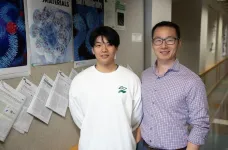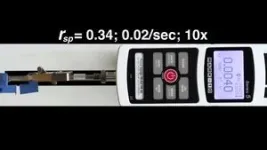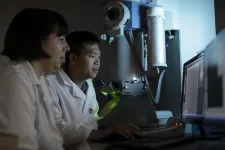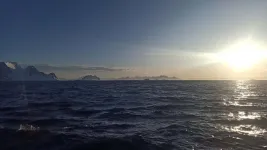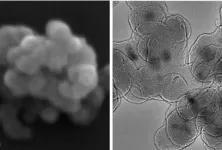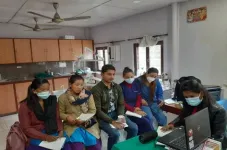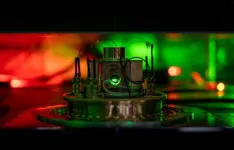(Press-News.org) Researchers at the University of Virginia School of Engineering and Applied Science have developed a new polymer design that appears to rewrite the textbook on polymer engineering. No longer is it dogma that the stiffer a polymeric material is, the less stretchable it has to be.
“We are addressing a fundamental challenge that has been thought to be impossible to solve since the invention of vulcanized rubber in 1839,” said Liheng Cai, an assistant professor of materials science and engineering, and chemical engineering.
That’s when Charles Goodyear accidentally discovered that heating natural rubber with sulfur created chemical crosslinks between the strand-like rubber molecules. This crosslinking process creates a polymer network, transforming the sticky rubber, which melts and flows in the heat, into a durable, elastic material.
Ever since, it’s been believed that if you want to make a polymer network material stiff, you have to sacrifice some stretchability.
That is, until Cai’s team, led by Ph.D. student Baiqiang Huang, proved otherwise with their new “foldable bottlebrush polymer networks.” Their work, funded by Cai’s National Science Foundation CAREER Award, is on the cover of the Nov. 27 issue of Science Advances.
‘Decoupling’ Stiffness and Stretchiness
“This limitation has held back the development of materials that need to be both stretchable and stiff, forcing engineers to choose one property at the expense of the other,” Huang said. “Imagine, for example, a heart implant that bends and flexes with each heartbeat but still lasts for years.”
Huang first-authored the paper with postdoctoral researcher Shifeng Nian and Cai.
Crosslinked polymers are everywhere in products we use, from automobile tires to home appliances — and they are increasingly used in biomaterials and health care devices.
Some applications the team envisions for their material include prosthetics and medical implants, improved wearable electronics, and “muscles” for soft robotic systems that need to flex, bend and stretch repeatedly.
Stiffness and extensibility — how far a material can stretch or expand without breaking — are linked because they originate from the same building block: the polymer strands connected by crosslinks. Traditionally, the way to stiffen a polymer network is to add more crosslinks.
This stiffens the material but doesn’t solve the stiffness-stretchability trade-off. Polymer networks with more crosslinks are stiffer, but they don’t have the same freedom to deform, and they break easily when stretched.
“Our team realized that by designing foldable bottlebrush polymers that could store extra length within their own structure, we could ‘decouple’ stiffness and extensibility — in other words, build in stretchability without sacrificing stiffness,” Cai said. “Our approach is different because it focuses on the molecular design of the network strands rather than crosslinks.”
How the Foldable Design Works
Instead of linear polymer strands, Cai’s structure resembles a bottlebrush — many flexible side chains radiating out from a central backbone.
Critically, the backbone can collapse and expand like an accordion that unfolds as it stretches. When the material is pulled, hidden length inside the polymer uncoils, allowing it to elongate up to 40 times more than standard polymers without weakening.
Meanwhile, the side chains determine stiffness, meaning that stiffness and stretchability can finally be controlled independently.
This is a “universal” strategy for polymer networks because the components that make up the foldable bottlebrush polymer structure are not restricted to specific chemical types.
For example, one of their designs uses a polymer for the side chains that stays flexible even in cold temperatures. But using a different synthetic polymer, one that is commonly used in biomaterial engineering, for the side chains can produce a gel that can mimic living tissue.
Like many of the novel materials developed in Cai’s lab, the foldable bottlebrush polymer is designed to be 3D-printable. This is true even when mixed with inorganic nanoparticles, which can be designed to exhibit intricate electric, magnetic or optical properties.
For example, they can add conductive nanoparticles, such as silver or gold nanorods, which are critical to stretchable and wearable electronics.
“These components give us endless options for designing materials that balance strength and stretchability while harnessing the properties of inorganic nanoparticles based on specific requirements,” Cai said.
Publications and More Reading
“A universal strategy for decoupling stiffness and extensibility of polymer networks” is published in Science Advances. The team published foundational research for this work last year in Macromolecules, titled Unexpected Folding of Bottlebrush Polymers in Melts.
Learn more about Cai’s research:
Maximizing Biomedical Research
Lookalike Drug Carriers
Printing Voxel Building Blocks
Challenging a 30-Year Dogma
About UVA Engineering
At UVA Engineering, we are building a brighter future through engineering for the greater good. Our mission is to make the world a better place through bold research and world-class education, putting people at the center of innovation. Our vibrant, diverse community attracts outstanding students and faculty from around the world to our internationally recognized education and research programs, where we are making groundbreaking discoveries in fields including artificial intelligence, hypersonics, cancer research and more. UVA Engineering is part of the top-ranked University of Virginia and is distinguished by a community of care where collegiality, support and engineering ethics thrive.
END
In major materials breakthrough, UVA team solves a nearly 200-year-old challenge in polymers
UVA researchers defy materials science rules with molecules that release stored length to decouple stiffness and stretchability
2024-11-27
ELSE PRESS RELEASES FROM THIS DATE:
Wyoming research shows early North Americans made needles from fur-bearers
2024-11-27
A Wyoming archaeological site where people killed or scavenged a Columbian mammoth nearly 13,000 years ago has produced yet another discovery that sheds light on the life of these early inhabitants of North America.
Wyoming State Archaeologist Spencer Pelton and colleagues at the University of Wyoming and other institutions have found that these Paleolithic humans made needles from the bones of fur-bearers -- including foxes; hares or rabbits; and cats such as bobcats, mountain lions, lynx and possibly even the now-extinct ...
Preclinical tests show mRNA-based treatments effective for blinding condition
2024-11-27
A new preclinical study by Mass Eye and Ear investigators showed that a novel mRNA-based therapy may be able to prevent blindness and scarring from proliferative vitreoretinopathy (PVR) following a retinal detachment repair or traumatic injury to the eye. There is no current treatment for PVR other than surgery, which itself carries a high risk of causing or exacerbating PVR. Their results, published in Science Translational Medicine, show the promise that mRNA-based therapies may one day offer patients with PVR and other retinal conditions.
“This ...
Velcro DNA helps build nanorobotic Meccano
2024-11-27
Researchers at the University of Sydney Nano Institute have made a significant advance in the field of molecular robotics by developing custom-designed and programmable nanostructures using DNA origami.
This innovative approach has potential across a range of applications, from targeted drug delivery systems to responsive materials and energy-efficient optical signal processing. The method uses ‘DNA origami’, so-called as it uses the natural folding power of DNA, the building blocks of human life, to create new and useful biological structures.
As a proof-of-concept, the researchers made more than 50 nanoscale objects, including a ‘nano-dinosaur’, ...
Oceans emit sulfur and cool the climate more than previously thought
2024-11-27
Researchers have quantified for the first time the global emissions of a sulfur gas produced by marine life, revealing it cools the climate more than previously thought, especially over the Southern Ocean.
The study, published in the journal Science Advances, shows that the oceans not only capture and redistribute the sun's heat, but produce gases that make particles with immediate climatic effects, for example through the brightening of clouds that reflect this heat.
It broadens the climatic impact of marine sulfur because it adds a new compound, methanethiol, that had previously gone unnoticed. Researchers only detected the gas recently, because ...
Nanorobot hand made of DNA grabs viruses for diagnostics and blocks cell entry
2024-11-27
CHAMPAIGN, Ill. — A tiny, four-fingered “hand” folded from a single piece of DNA can pick up the virus that causes COVID-19 for highly sensitive rapid detection and can even block viral particles from entering cells to infect them, University of Illinois Urbana-Champaign researchers report. Dubbed the NanoGripper, the nanorobotic hand also could be programmed to interact with other viruses or to recognize cell surface markers for targeted drug delivery, such as for cancer treatment.
Led by Xing Wang, a professor of bioengineering and of chemistry at the ...
Rare, mysterious brain malformations in children linked to protein misfolding, study finds
2024-11-27
In 1992, Judith Frydman, PhD, discovered a molecular complex with an essential purpose in all of our cells: folding proteins correctly.
The complex, a type of “protein chaperone” known as TRiC, helps fold thousands of human proteins: It was later found that about 10% of all our proteins pass through its barrel structure.
All animals have several different kinds of protein chaperones, each with its own job of helping fold proteins in the cell. TRiC binds to newborn proteins and shapes these strings of amino acids into the correct 3D structures, ...
Newly designed nanomaterial shows promise as antimicrobial agent
2024-11-27
HOUSTON – (Nov. 27, 2024) – Newly developed halide perovskite nanocrystals (HPNCs) show potential as antimicrobial agents that are stable, effective and easy to produce. After almost three years, Rice University scientist Yifan Zhu and colleagues have developed a new HPNC that is effective at killing bacteria in a biofluid under visible light without experiencing light- and moisture-driven degradation common in HPNCs.
A new method using two layers of silicon dioxide that Zhu and colleagues developed over years of work was used in experiments with lead-based and bismuth-based HPNCs to test their antimicrobial efficacy and stability in water. ...
Scientists glue two proteins together, driving cancer cells to self-destruct
2024-11-27
Our bodies divest themselves of 60 billion cells every day through a natural process of cell culling and turnover called apoptosis.
These cells — mainly blood and gut cells — are all replaced with new ones, but the way our bodies rid themselves of material could have profound implications for cancer therapies in a new approach developed by Stanford Medicine researchers.
They aim to use this natural method of cell death to trick cancer cells into disposing of themselves. Their method accomplishes this by artificially bringing together two proteins in such a way that the new compound switches on a set of cell death genes, ultimately driving tumor cells to turn on themselves. ...
Intervention improves the healthcare response to domestic violence in low- and middle-income countries
2024-11-27
Culturally appropriate women-centred interventions can help healthcare systems respond to domestic violence, research has found. HERA (Healthcare Responding to Violence and Abuse) has been co-developing and evaluating a domestic violence and abuse healthcare intervention in low- and middle-income countries for the past five years. This National Institute for Health and Care Research (NIHR) Global Research Group will report their findings, and publish a PolicyBristol report, at a conference in London today ...
State-wide center for quantum science: Karlsruhe Institute of Technology joins IQST as a new partner
2024-11-27
The mission of IQST is to further our understanding of nature and develop innovative technologies based on quantum science by leveraging synergies between the natural sciences, engineering, and life sciences. "Many KIT scientists already successfully support IQST with their expertise as Fellows. All the more I am pleased that the Karlsruhe Institute of Technology is now joining our interdisciplinary centre as an institution," says IQST Director Prof. Stefanie Barz. "This will strengthen networking within the academic quantum community in Baden-Württemberg," emphasizes ...
LAST 30 PRESS RELEASES:
Tracing the quick synthesis of an industrially important catalyst
New software sheds light on cancer’s hidden genetic networks
UT Health San Antonio awarded $3 million in CPRIT grants to bolster cancer research and prevention efforts in South Texas
Third symposium spotlights global challenge of new contaminants in China’s fight against pollution
From straw to soil harmony: International team reveals how biochar supercharges carbon-smart farming
Myeloma: How AI is redrawing the map of cancer care
Manhattan E. Charurat, Ph.D., MHS invested as the Homer and Martha Gudelsky Distinguished Professor in Medicine at the University of Maryland School of Medicine
Insilico Medicine’s Pharma.AI Q4 Winter Launch Recap: Revolutionizing drug discovery with cutting-edge AI innovations, accelerating the path to pharmaceutical superintelligence
Nanoplastics have diet-dependent impacts on digestive system health
Brain neuron death occurs throughout life and increases with age, a natural human protein drug may halt neuron death in Alzheimer’s disease
SPIE and CLP announce the recipients of the 2025 Advanced Photonics Young Innovator Award
Lessons from the Caldor Fire’s Christmas Valley ‘Miracle’
Ant societies rose by trading individual protection for collective power
Research reveals how ancient viral DNA shapes early embryonic development
A molecular gatekeeper that controls protein synthesis
New ‘cloaking device’ concept to shield sensitive tech from magnetic fields
Researchers show impact of mountain building and climate change on alpine biodiversity
Study models the transition from Neanderthals to modern humans in Europe
University of Phoenix College of Doctoral Studies releases white paper on AI-driven skilling to reduce burnout and restore worker autonomy
AIs fail at the game of visual “telephone”
The levers for a sustainable food system
Potential changes in US homelessness by ending federal support for housing first programs
Vulnerability of large language models to prompt injection when providing medical advice
Researchers develop new system for high-energy-density, long-life, multi-electron transfer bromine-based flow batteries
Ending federal support for housing first programs could increase U.S. homelessness by 5% in one year, new JAMA study finds
New research uncovers molecular ‘safety switch’ shielding cancers from immune attack
Bacteria resisting viral infection can still sink carbon to ocean floor
Younger biological age may increase depression risk in older women during COVID-19
Bharat Innovates 2026 National Basecamp Showcases India’s Most Promising Deep-Tech Ventures
Here’s what determines whether your income level rises or falls
[Press-News.org] In major materials breakthrough, UVA team solves a nearly 200-year-old challenge in polymersUVA researchers defy materials science rules with molecules that release stored length to decouple stiffness and stretchability
